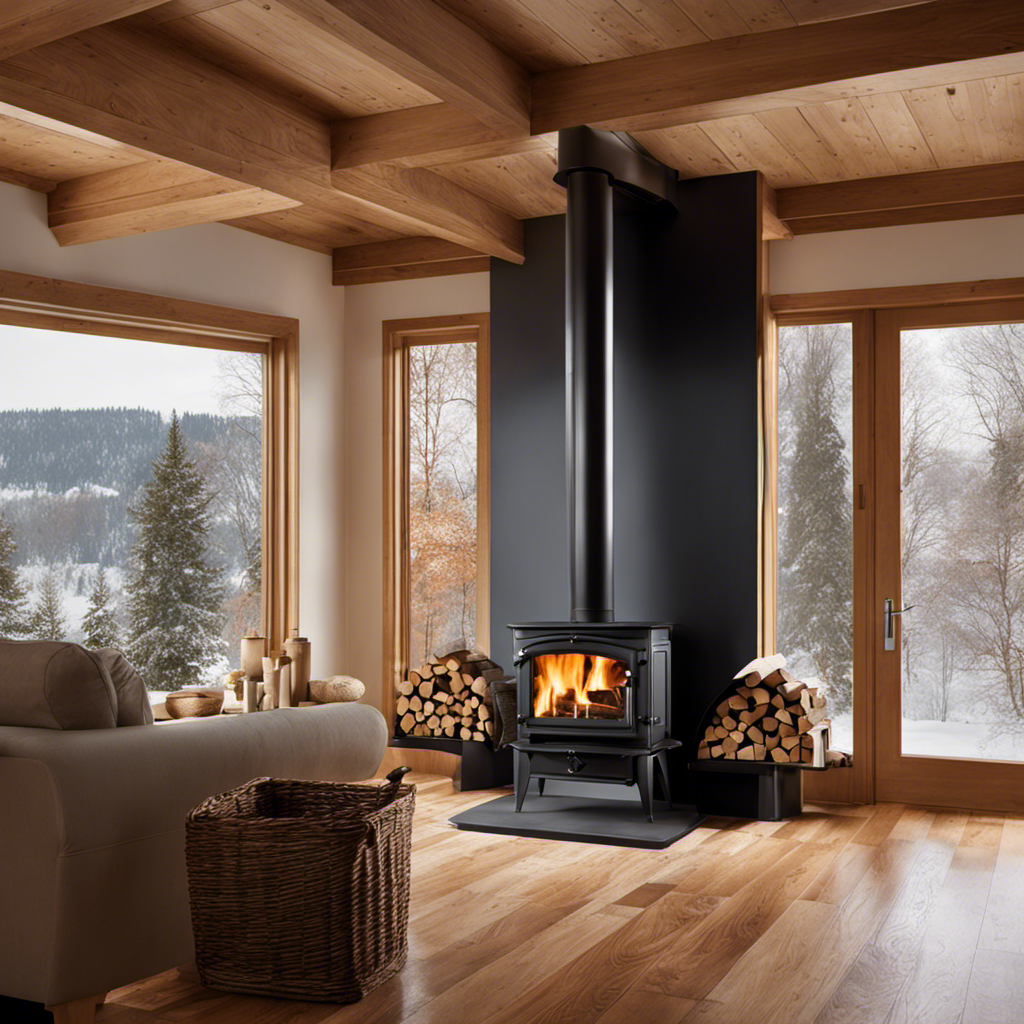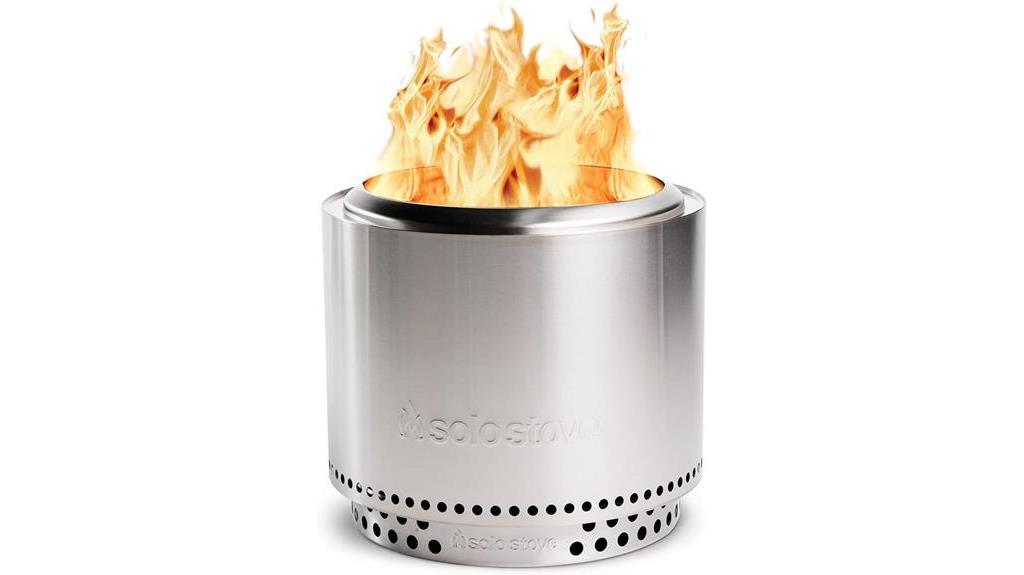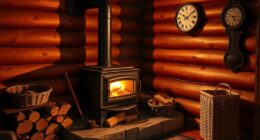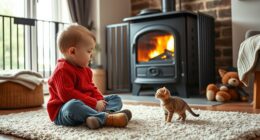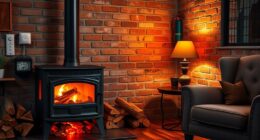So, you’ve made the decision to incorporate a warm wood stove into your living area? Excellent decision!
In this step-by-step guide, I’ll walk you through the process of installing a wood stove in your house.
From choosing the perfect location to connecting the flue pipe, I’ll cover all the important details.
By the end, you’ll be ready to enjoy the warmth and comfort of your new wood stove while keeping your home safe and cozy.
Let’s get started!
Key Takeaways
- Choose a location for the wood stove that is at least three feet away from flammable materials and has proper clearance around it.
- Conduct a thorough chimney inspection and make any necessary repairs before installing the wood stove.
- Install the wood stove near a wall or an area with access to an exterior wall for proper ventilation.
- Regularly test and maintain the wood stove for safe operation, including checking for cracks or damage, ensuring proper ventilation, and cleaning the chimney regularly.
Choosing the Right Location for Your Wood Stove
I’ve been researching the best location for my wood stove and I think I’ve found the perfect spot in my living room.
When it comes to safety considerations for wood stove installation, it’s crucial to choose a location that reduces the risk of fire hazards.
First, make sure to keep the stove at least three feet away from any flammable materials, such as curtains or furniture.
Additionally, ensure that there’s proper clearance around the stove to prevent any accidental contact with combustible surfaces.
Another important factor to consider when positioning a wood stove in your home is the proximity to a chimney or venting system. Placing the stove near an existing chimney can simplify the installation process and improve the efficiency of heat distribution.
Lastly, think about the layout of your living room and how the stove will fit into the overall design. Make sure there’s adequate space for comfortable seating, and that the stove isn’t obstructing any doorways or walkways.
Assessing and Preparing Your Chimney for Installation
Assessing the condition of my chimney and preparing it for installation is an essential step in ensuring the safe and efficient operation of my wood stove. Here’s a step-by-step guide on how to assess and prepare your chimney for installation:
- Start by conducting a thorough chimney inspection to check for any signs of damage or deterioration.
- Look for cracks, loose bricks, or mortar joints that may require chimney repair.
- Clean out any debris or creosote buildup from the chimney to ensure proper airflow.
- Install a chimney cap to prevent birds, animals, and debris from entering the chimney.
- Consider hiring a professional chimney sweep to perform a more detailed inspection and address any necessary repairs.
By properly assessing and preparing your chimney, you can ensure that it’s in good condition and ready for the installation of your wood stove.
Now, let’s move on to the next step: selecting and preparing the wood stove installation site.
Selecting and Preparing the Wood Stove Installation Site
Finding the ideal location for the wood stove installation involves considering factors such as clearance requirements, ventilation, and aesthetics.
To begin, it’s crucial to identify a spot that meets the necessary clearance requirements. The stove should be placed at least three feet away from any combustible materials, such as furniture or curtains.
Additionally, proper ventilation is paramount. The stove should be installed near a wall or in an area with access to an exterior wall, allowing for the installation of a vent pipe. This will ensure the safe removal of smoke and combustion gases.
Lastly, aesthetics shouldn’t be overlooked. Consider a location that enhances the overall design of the room.
Installing the Wood Stove and Connecting the Flue Pipe
I can easily install the wood stove and connect the flue pipe using the proper tools and materials. Here’s a step-by-step guide on how to do it:
- Start by positioning the wood stove in the desired location, ensuring it meets the required clearance distances.
- Connect the stovepipe to the stove’s flue collar, making sure to use a high-quality stovepipe connector.
- Attach the other end of the stovepipe to the chimney or flue liner, securing it tightly with stainless steel screws or clamps.
- Inspect the stovepipe joints for any gaps or leaks, and seal them using high-temperature silicone or stovepipe tape.
- Finally, ensure proper ventilation by opening the damper and checking that there’s no blockage in the chimney or flue.
By following these steps, you can safely connect the stovepipe and maintain proper ventilation for your wood stove installation.
Now, let’s move on to the next section and discuss testing and maintaining your wood stove for safe operation.
Testing and Maintaining Your Wood Stove for Safe Operation
I regularly check and clean my wood stove to ensure safe operation during the winter months. Safety precautions are essential when it comes to using a wood stove, as it involves fire and potential hazards. Here are some troubleshooting tips to maintain the safety of your wood stove:
| Safety Precautions | Troubleshooting Tips |
|---|---|
| Use a fireproof hearth | Check for any cracks or damage in the stove |
| Keep flammable items away | Ensure proper ventilation by opening the damper |
| Install a carbon monoxide detector | Clean the chimney regularly to remove creosote buildup |
| Have a fire extinguisher nearby | Check the gasket seals for wear and tear |
Frequently Asked Questions
What Are the Different Types of Wood Stoves Available in the Market?
There are various types of wood stoves available in the market. Each type has its pros and cons. Factors to consider when choosing include size, efficiency, and emissions. Popular brands include Vermont Castings and Jøtul. Prices range from $500 to $3000.
How Do I Determine the Right Size of Wood Stove for My House?
Choosing the right size wood stove for your house is crucial. To determine the size, calculate your heat requirements by considering the square footage, insulation, and climate. This ensures optimal heating efficiency.
Are There Any Building Codes or Regulations That I Need to Comply With When Installing a Wood Stove?
Yes, there are building code requirements and safety regulations that need to be followed when installing a wood stove. These rules ensure proper ventilation, clearances, and fire safety measures to protect your home.
Can a Wood Stove Be Installed in a Mobile Home?
Installing a wood stove in a mobile home is possible, but it requires careful consideration. You should use a vent pipe instead of a chimney and ensure compliance with building codes and regulations.
How Often Should I Clean and Maintain My Wood Stove for Optimal Performance?
I clean and maintain my wood stove for optimal performance every year. Regular cleaning reduces creosote buildup, prevents chimney fires, and ensures efficient heating. The benefits of using a wood stove in a house include cost savings and cozy warmth.
Conclusion
After following these step-by-step instructions, you’ll be able to enjoy the cozy warmth and ambiance of a wood stove in your home.
With proper installation and maintenance, your wood stove will provide you with years of safe and efficient heating.
So why wait? Get started now and transform your house into a haven of comfort and relaxation.
Logan’s affair with adventure began in childhood. He hailed from a small town where vast forests bordered one side and endless shores stretched on the other. His days were spent exploring uncharted woods, climbing tall trees, or listening to the tales of old sailors. This early immersion in a world brimming with stories and mysteries became the foundation of his passion for writing.

